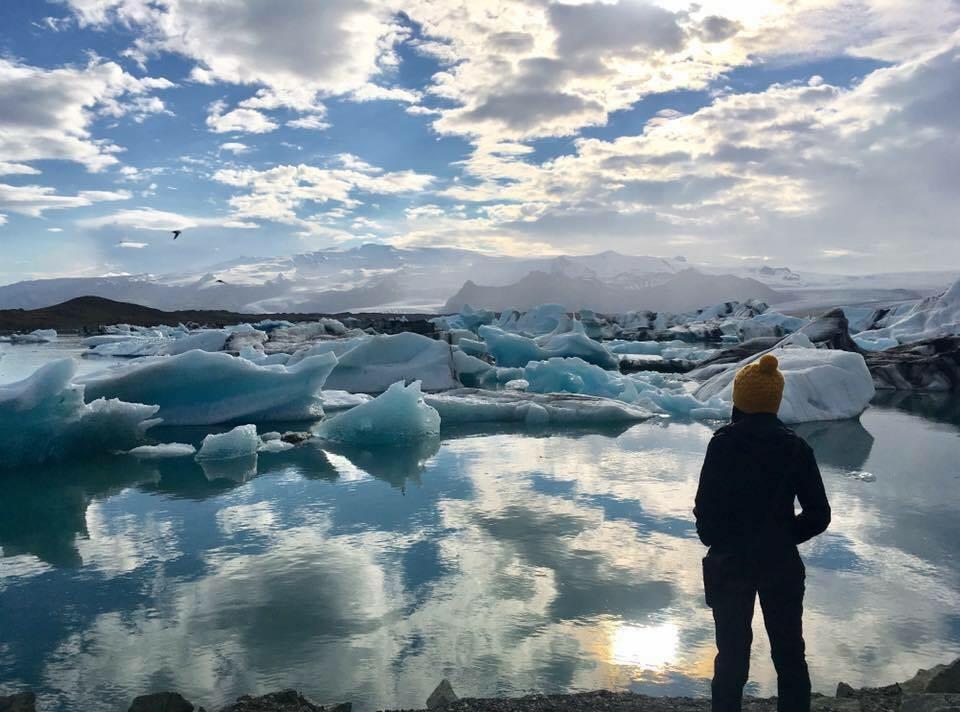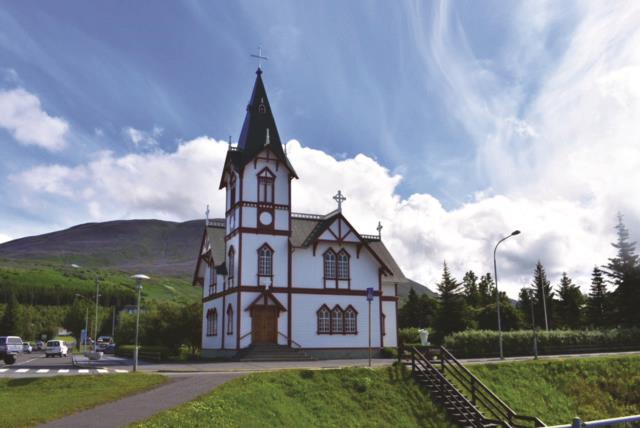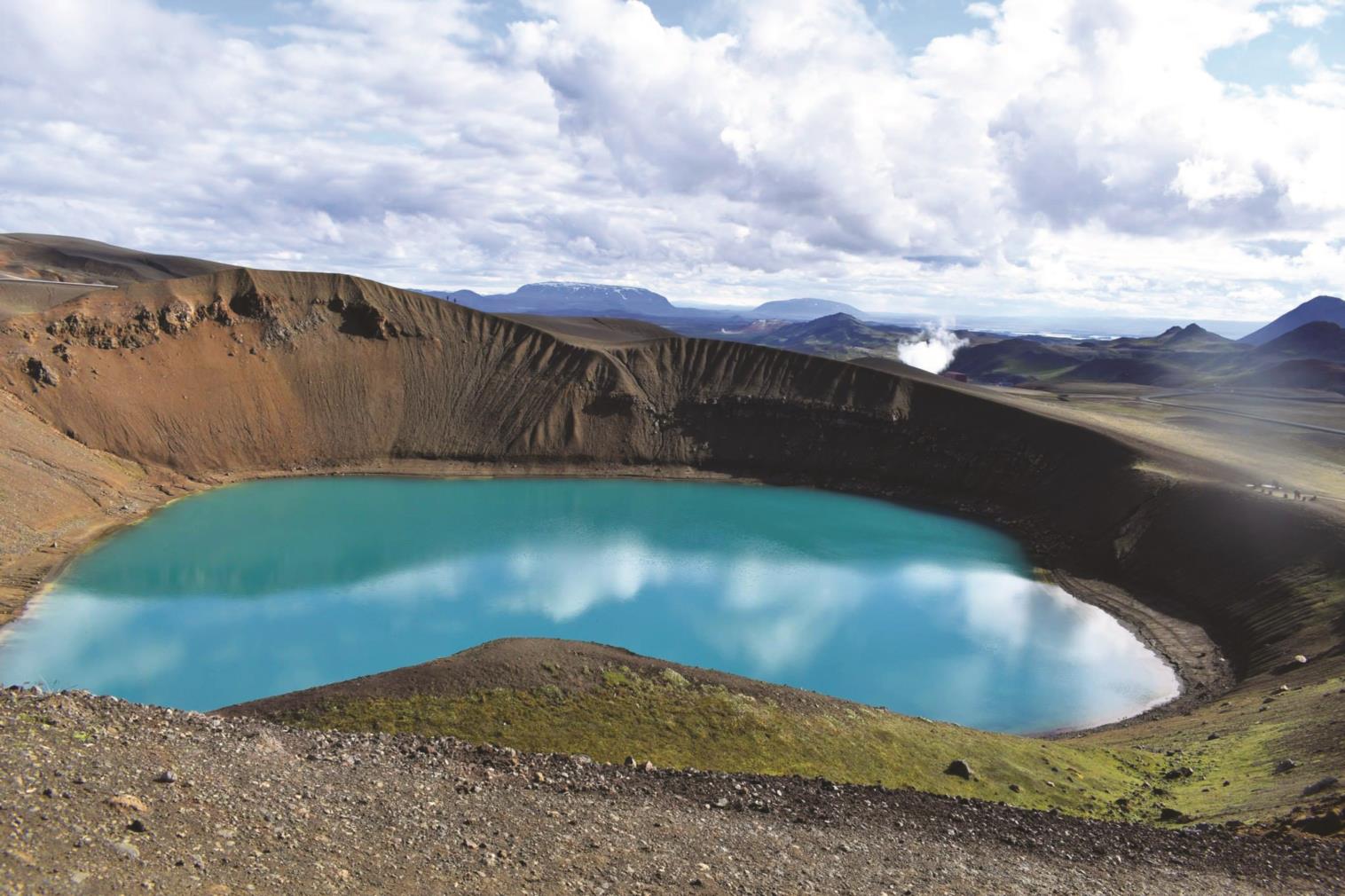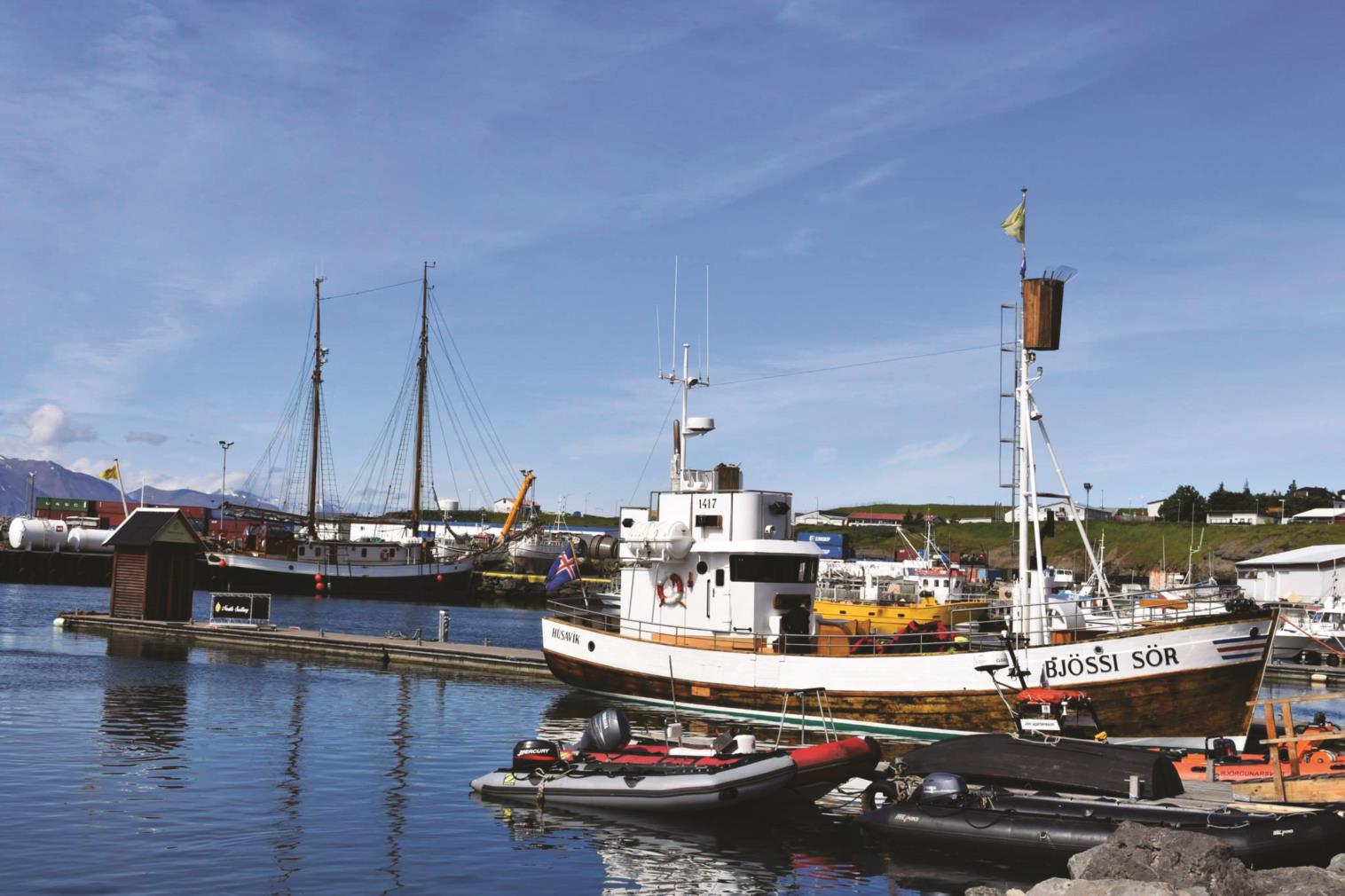 As my wife snaps photos, I chase my children down the path toward the lagoon. We hop over a small stream of glacier melt, and then I try to teach my son how to skip stones in the lagoon while my daughter stacks them in piles on the rocky beach.
Our trip has been full of moments like this—everyday family activities occurring in surreal settings. Iceland is a place where the world shows its age, where it’s easy to see evidence of the centuries and millennia stacked on top of each other in the landscape. Earlier in the trip, the kids scrambled up jagged formations in a lava field called Dimmuborgir (“Dark Castles”) in the country’s north, peeking out from behind towers created 2,000 years ago. Later that same day, we hiked up a 2,700-year-old volcanic crater and around another one that was formed in 1724—ancient history to us, but barely a moment ago in geological terms. One of our favorite stops was Hverir, a geothermal site where sulfurous steam pipes up out of the cracks between rocks, and where the soil in some spots bubbles up blue. Walking there, I had the feeling that the earth was just barely stable, like a pot on the cusp of boiling over.
As my wife snaps photos, I chase my children down the path toward the lagoon. We hop over a small stream of glacier melt, and then I try to teach my son how to skip stones in the lagoon while my daughter stacks them in piles on the rocky beach.
Our trip has been full of moments like this—everyday family activities occurring in surreal settings. Iceland is a place where the world shows its age, where it’s easy to see evidence of the centuries and millennia stacked on top of each other in the landscape. Earlier in the trip, the kids scrambled up jagged formations in a lava field called Dimmuborgir (“Dark Castles”) in the country’s north, peeking out from behind towers created 2,000 years ago. Later that same day, we hiked up a 2,700-year-old volcanic crater and around another one that was formed in 1724—ancient history to us, but barely a moment ago in geological terms. One of our favorite stops was Hverir, a geothermal site where sulfurous steam pipes up out of the cracks between rocks, and where the soil in some spots bubbles up blue. Walking there, I had the feeling that the earth was just barely stable, like a pot on the cusp of boiling over.
 Iceland lends itself to this sort of magical thinking. It’s a land where the sun never sets in summer, and where the night skies are streaked with colorful lights in the winter; where seemingly every waterfall and rock formation has a backstory involving trolls or elves or gods; where flower-filled meadows and spiking mountains and placid lakes and volcanic-ash moonscapes all occupy a single vista.
It’s a land where nature overwhelms civilization, where you can picture the world spinning on into eternity long after we’re all gone.
We hike back to the car and drive to see another outlet glacier, before making our way to Jökulsárlón, a glacial lake that has been at the top of my to-see list since we booked our trip. Here, chunks of the glacier that feeds the lagoon break off into icebergs that slowly drift past and crash into one another until they either melt or are washed out to sea. The icebergs, which are often described as being a “ghostly” blue, start off the size of buildings, but then gradually shrink down to ice cubes.
Iceland lends itself to this sort of magical thinking. It’s a land where the sun never sets in summer, and where the night skies are streaked with colorful lights in the winter; where seemingly every waterfall and rock formation has a backstory involving trolls or elves or gods; where flower-filled meadows and spiking mountains and placid lakes and volcanic-ash moonscapes all occupy a single vista.
It’s a land where nature overwhelms civilization, where you can picture the world spinning on into eternity long after we’re all gone.
We hike back to the car and drive to see another outlet glacier, before making our way to Jökulsárlón, a glacial lake that has been at the top of my to-see list since we booked our trip. Here, chunks of the glacier that feeds the lagoon break off into icebergs that slowly drift past and crash into one another until they either melt or are washed out to sea. The icebergs, which are often described as being a “ghostly” blue, start off the size of buildings, but then gradually shrink down to ice cubes.
 We get out of the car and walk along the water’s edge, watching braver souls wade into the freezing water in their bare feet to create the ultimate travel photo. It’s strange how the site seems almost perfectly designed for tourism, with the feel of a film set (in fact, Jökulsárlón has appeared in several blockbusters, including two Bond installments) and a location right next to the highway. It’s both accessible and otherworldly. But it’s also entirely accidental. Less than 100 years ago, there was no lagoon here at all. Today, Jökulsárlón is Iceland’s deepest lake.
We get out of the car and walk along the water’s edge, watching braver souls wade into the freezing water in their bare feet to create the ultimate travel photo. It’s strange how the site seems almost perfectly designed for tourism, with the feel of a film set (in fact, Jökulsárlón has appeared in several blockbusters, including two Bond installments) and a location right next to the highway. It’s both accessible and otherworldly. But it’s also entirely accidental. Less than 100 years ago, there was no lagoon here at all. Today, Jökulsárlón is Iceland’s deepest lake.
 The site is teeming with tourists, and I’m relieved that we booked our tickets weeks ago for the amphibious boat that will take us out among the icebergs. We’re an hour early, and as we wait, we walk along the water’s edge, compulsively snapping photos. The scene changes with every shift in the light and every pass of an iceberg, and I don’t want to miss anything. In places where the ice has been broken down, the lagoon looks like slush. In other spots, small, jagged icebergs jut up out of the water like shards of glass. At the center of the lake sit the largest formations, looming and castle-like, presumably anchored by foundations that stretch hundreds of feet down into the depths.
We board the boat on land, donning orange life vests, and then we slowly crunch over a stone path as we drive into the water. Much of our Iceland adventure has been gray and drizzly, but it’s a blue-sky day, and the sun is blindingly bright.
The site is teeming with tourists, and I’m relieved that we booked our tickets weeks ago for the amphibious boat that will take us out among the icebergs. We’re an hour early, and as we wait, we walk along the water’s edge, compulsively snapping photos. The scene changes with every shift in the light and every pass of an iceberg, and I don’t want to miss anything. In places where the ice has been broken down, the lagoon looks like slush. In other spots, small, jagged icebergs jut up out of the water like shards of glass. At the center of the lake sit the largest formations, looming and castle-like, presumably anchored by foundations that stretch hundreds of feet down into the depths.
We board the boat on land, donning orange life vests, and then we slowly crunch over a stone path as we drive into the water. Much of our Iceland adventure has been gray and drizzly, but it’s a blue-sky day, and the sun is blindingly bright.
 As we gently motor along, rounding the icebergs, our guide—a young, bearded Frenchman—tells us about the site: its relative youth, its exponential growth, its famous film cameos. His assistant pulls a block of ice up out of the water, and together they shatter it, and then pass the ice chips around for us to taste. “This ice is more than a thousand years old,” the guide says.
I lick my little ice cube. It’s too cold to really tell, but I think there’s a mineral-y taste to it. Then I put the chunk in my palm, and it melts away. A thousand years old, and it’s gone.
“I wish more people from around the world would come here,” says the guide. “Then they would see with their own eyes that global warming is real.”
“It’s beautiful, though,” says a tourist.
“Yes,” says the guide, squinting against the sun. As we make our way back toward land, the boat glides past a medium-sized iceberg, corpselike in its bluish pallor. “It is beautiful, and it is sad.
iceland.is
As we gently motor along, rounding the icebergs, our guide—a young, bearded Frenchman—tells us about the site: its relative youth, its exponential growth, its famous film cameos. His assistant pulls a block of ice up out of the water, and together they shatter it, and then pass the ice chips around for us to taste. “This ice is more than a thousand years old,” the guide says.
I lick my little ice cube. It’s too cold to really tell, but I think there’s a mineral-y taste to it. Then I put the chunk in my palm, and it melts away. A thousand years old, and it’s gone.
“I wish more people from around the world would come here,” says the guide. “Then they would see with their own eyes that global warming is real.”
“It’s beautiful, though,” says a tourist.
“Yes,” says the guide, squinting against the sun. As we make our way back toward land, the boat glides past a medium-sized iceberg, corpselike in its bluish pallor. “It is beautiful, and it is sad.
iceland.is
